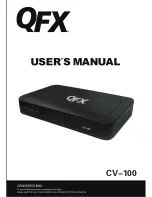
Introduction to the Basic Encoder
Page 1-14
Instruction Manual: evolution 5000 E5710 and E5720 Encoder
ST.TM.E10074.1
VBI in PID
The Encoder has the ability to extract and transmit a wide variety of VBI
line formats. Field Programmable Gate Array (FPGA) circuitry on the front
end of the equipment incorporates a number of general purpose line
grabbers so that known formats of VBI data can be extracted.
The following VBI data formats are supported:
·
Line 21 (field 1 and field 2) data Services EIA-608 (Closed Caption and
V-chip)
·
Neilson AMOL 1, Neilson AMOL 11
·
VITC (EBU and SMPTE)
·
Programme Delivery Control (PDC), via ITU-R system B Teletext
extension data packets of type 8/30, format 2 and Line 16 Video
Programme System (VPS). Video Programming Teletext (VPT) and VPS
are trade names
·
Wide Screen Signalling (WSS) (line 23) ETS 300 294
·
Video Index (for Pan Scan, Aspect Ratio and Active Format Descriptor)
·
The supported VBI line number range is 10-22 and 272-285 for 525
lines and 7-24 and 319-336 for 625 lines
Teletext Extraction
The Encoder supports internal Teletext data extraction (Teletext drop)
from the VBI of a video input and formats this data into a transport
packet, as specified in the DVB specification EN300-472. The Encoder can
extract up to 18 lines of Teletext from each field of the video frame.
Line filters can be invoked to selectively disable any individual lines in this
range. The filters are provided to allow the user to ensure that
non-Teletext lines (e.g. ITS lines) are not erroneously extracted. The
extracted Teletext lines are formatted into PES packets according to the
DVB specification. The Teletext PES packets are time-stamped to allow
correct alignment of subtitling captions with decoded video.
The following Teletext services are extractable:
·
Sytem B (WST) Teletext
·
Video Programming Teletext (VPT), PDC (Packet 8/30 format 2)
·
Inverted Teletext
1.3.4
Outputs
Three ASI-C (copper) outputs supplying a DVB and ATSC MPEG-2
transport stream are supplied as standard.
1.3.5
Control and Monitoring
Remote control of the Encoder is via the Ethernet network running the
Simple Network Management Protocol (SNMP) protocol or via the
RS-232/RS-485 remote control port. The control devices include:
·
Multiplex Element Manager (MEM)
·
TANDBERG Director
·
STREAMS
·
Reflex
















































